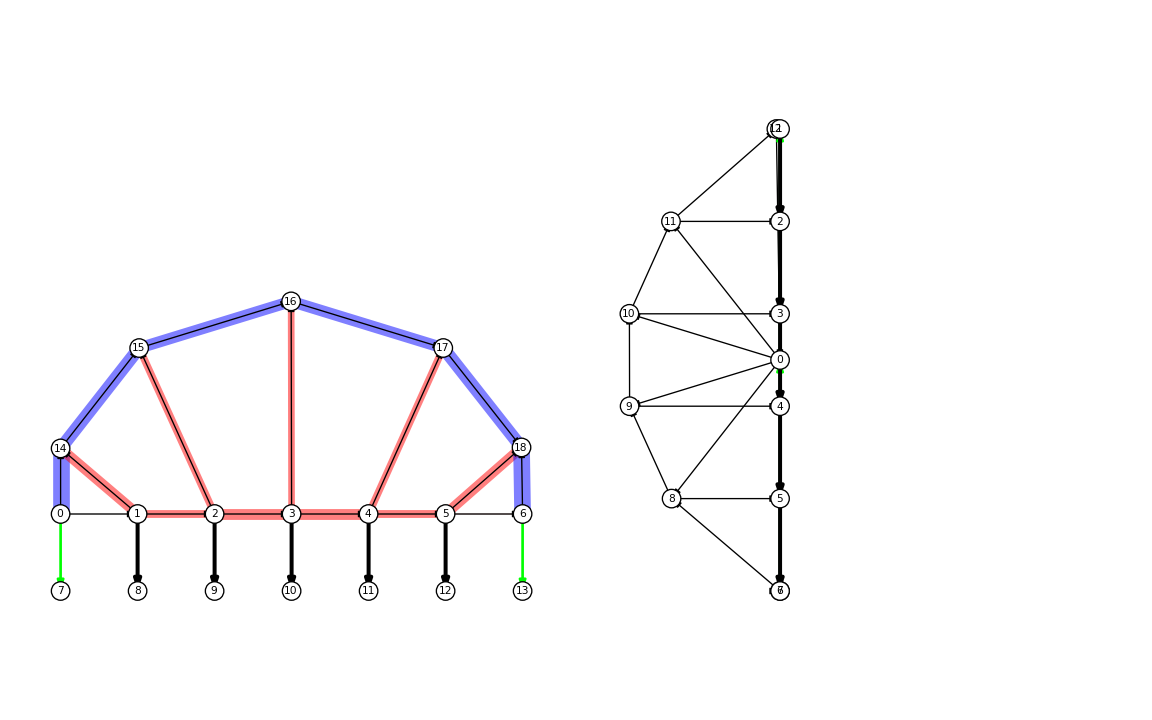from compas_ags.ags import graphstatics
from compas_ags.ags import loadpath
from compas_ags.diagrams import ForceDiagram
from compas_ags.diagrams import FormDiagram
from compas_ags.diagrams import FormGraph
from compas_ags.viewer import AGSViewer
# ------------------------------------------------------------------------------
# 1. create a planar truss structure, its applied loads and boundary conditions
# from nodes and edges
# make form and force diagrams
# ------------------------------------------------------------------------------
nodes = [
[0.0, 0.0, 0],
[1.0, 0.0, 0],
[2.0, 0.0, 0],
[3.0, 0.0, 0],
[4.0, 0.0, 0],
[5.0, 0.0, 0],
[6.0, 0.0, 0],
[0.0, -1.0, 0],
[1.0, -1.0, 0],
[2.0, -1.0, 0],
[3.0, -1.0, 0],
[4.0, -1.0, 0],
[5.0, -1.0, 0],
[6.0, -1.0, 0],
[1.0, +1.0, 0],
[2.0, +1.0, 0],
[3.0, +1.0, 0],
[4.0, +1.0, 0],
[5.0, +1.0, 0],
]
edges = [
(0, 1),
(1, 2),
(2, 3),
(3, 4),
(4, 5),
(5, 6),
(0, 7),
(1, 8),
(2, 9),
(3, 10),
(4, 11),
(5, 12),
(6, 13),
(0, 14),
(14, 15),
(15, 16),
(16, 17),
(17, 18),
(18, 6),
(1, 14),
(2, 15),
(3, 16),
(4, 17),
(5, 18),
]
graph = FormGraph.from_nodes_and_edges(nodes, edges)
form = FormDiagram.from_graph(graph)
force = ForceDiagram.from_formdiagram(form)
# ------------------------------------------------------------------------------
# 2. assign applied loads to bottom chord
# ------------------------------------------------------------------------------
edges = [(8, 1), (9, 2), (10, 3), (11, 4), (12, 5)]
for edge in edges:
form.edge_attribute(edge, "is_ind", True)
form.edge_attribute(edge, "q", 1.0)
# update force densities of form and force diagram
graphstatics.form_update_q_from_qind(form)
graphstatics.force_update_from_form(force, form)
# ------------------------------------------------------------------------------
# 3. optimize the loadpath
# ------------------------------------------------------------------------------
# modify force in the truss by updating vertex coordinates of the force diagram
# force in members of the top chord and bottom chord are set to be the same
# now the form is no longer in equilibrium
force.vertex_attributes(1, "xy", [0, 2.5])
force.vertex_attributes(2, "xy", [0, 1.5])
force.vertex_attributes(3, "xy", [0, 0.5])
force.vertex_attributes(0, "xy", [0, 0])
force.vertex_attributes(4, "xy", [0, -0.5])
force.vertex_attributes(5, "xy", [0, -1.5])
force.vertex_attributes(6, "xy", [0, -2.5])
force.vertex_attributes(12, "xy", [-2, 2.5])
force.vertex_attributes(11, "xy", [-2, 1.5])
force.vertex_attributes(10, "xy", [-2, 0.5])
force.vertex_attributes(9, "xy", [-2, -0.5])
force.vertex_attributes(8, "xy", [-2, -1.5])
force.vertex_attributes(7, "xy", [-2, -2.5])
# forces in members of top chord and connecting struts are force domain parameters
force.vertices_attribute("is_param", True, keys=[7, 8, 9, 10, 11, 12])
# fix boundary vertices, the nodes of the bottom chord
form.vertices_attribute("is_fixed", True, keys=[0, 1, 2, 3, 4, 5, 6])
# optimize the loadpath and output the optimal distribution of forces that
# results in overall minimum-volumn solution for given form diagram
loadpath.optimise_loadpath(form, force)
# ------------------------------------------------------------------------------
# 4. display force and form diagrams
# ------------------------------------------------------------------------------
viewer = AGSViewer()
viewer.add_form(form, scale_forces=0.05)
viewer.add_force(force)
viewer.show()
